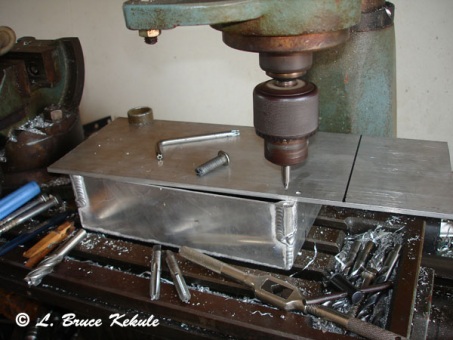HD Video Infrared Camera Trap
High-tech ‘homebrew’ video trail cam
A joint camera trap video program using a DXG 125r/1060/BF board-array video camera trap
Ron Davis DXG 125 video unit in a LBK elephant proof box
After seeing some of my posts, Ron Davis, a lawyer from Florida offered to send me an High Definition DXG 125R/BF board-array/IR/exchanger video unit housed in a Pelican 1060 (monster case) to put in Huai Kha Khaeng Wildlife Sanctuary where I’m presently doing a camera trap (presence/absense) survey. I gladly accepted the offer and waited patiently for the unit.
Machining elephant proof box
I have been running three Bushnell Trophy Cams (2009 & 2011 models) and was getting some amazing clips of large mammals like elephant, gaur, banteng, tiger and tapir plus other creatures at night, but also in broad daylight that was quite a surprise. I plan to share these videos with the forum soon. Most Asian animals are nocturnal for their own safety and have evolved this way due to centuries of human poaching pressure.
Drilling out LED ports on elephant proof box
However, as this World Heritage Site is being look after much better than any other protected area in Thailand, and its biodiversity is tops, wild creatures are beginning to feel more at ease about showing themselves during the day. It is a fact they will propagate and move freely in the day if undisturbed for the most part.
Video unit and elephant proof box before camouflage paint
I never have had a big Pelican 1060 and when it arrived in the post, my immediate reaction was it would be quite visible in the forest, and is also quite heavy with all the components including a 12v battery to run the array. However, I went to work building an elephant proof security box from aluminum.
Video unit and elephant proof and ‘Python’ locking cable ready for the field
I got my Tig-welder to make it up and did all the machining required. It was just in the outer limits of travel on the table of my small milling machine but it was OK. I had to do some juggling but I got it done using precision drilling with a center drill first followed by a drill bit, a hole-cutter and milling cutter. The LED ports took awhile to get all 12 finished.
I then painted it with a new camouflage technique for me. Using four colors (black primer coat, then khaki, army green and earth brown in conjunction with bamboo leaves (idea from my friend Chris Wemmer – the Camera Trap Codger), I painted the box in succession until I was satisfied. It looked pretty good to me and it certainly would blend in with the surrounding vegetation.
Ron Davis/LBK video unit at a waterhole in Huai Kha Khaeng
I made my monthly trip on April 15th to the sanctuary and the first night set the unit over a really bad smelling bag of rotten chicken (a previous bait and two weeks old)…whew! This was quite close to the ranger station I always stay at and early the next morning about 4am, I heard an Asiatic jackal barking close to the cam that could possibly mean a leopard. The bait was gone the next morning but I did not check the files deciding to wait.
I then moved it to a very productive water hole where it is now. When I return from Africa, I will be going straight in to check all my traps including this unit. Can’t wait to see what it has captured and will of course share any videos later on this website. I would like to thank Ron Davis for the use of his video unit and let’s see what it gets.







